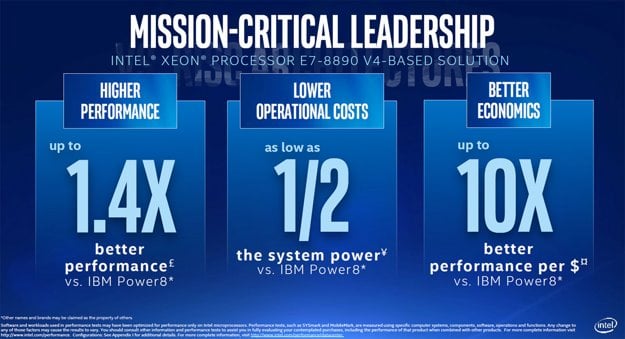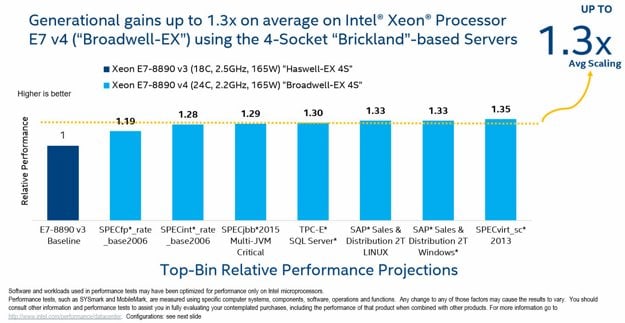Intel Announces Xeon E7 v4 Processors For Mission-Critical Computing And The Cloud
Xeon E7 v4 Expected Performance And Summary
We haven’t had the chance to take a Xeon E7 v4-based system for a spin, but Intel provided a bit of performance data to illustrate where the Xeon E7 v4 should fall-in versus the previous generation and some competitive offerings.
Versus IBM Power8, for example, Intel claims 40% better performance, for roughly half the power. In terms of performance-per-dollar, the Xeon E7 v4 reportedly offers a 10-fold increase.
In a 4-socket Brickland-based server powered by a quartet of E7-8890s, in comparison to last year’s Xeon E7 v3 series parts, the new Xeon E7 v4 series is an average of about 30% faster across the board. SPECvirt-DC 2013 shows the largest gain of about 35%, while SPECfp shown an uplift of 19%.
A number of Intel’s partners that have been qualifying the Xeon E7 v4-series parts have also reported significant performance gains. Caterpillar reports a 3.66x increase in network throughput with the E7 v4 after optimizing performance with VTune and the Actian analytics platform reports a 2x increase in queries per hour. Other gains hover in the 1.26x – 1.51x range.
For direct generational comparisons, in addition to core counts, cache, and base/turbo frequencies, Intel provided the data above. In every segment, except the basic segment, the new E7 v4 series processors gain additional cores and cache versus their predecessors. Frequencies may be somewhat higher or lower, however, depending on the number of additional cores featured in the chips. Intel expects performance improvements across the line-up though, and all of the processors feature similar power envelopes.
Intel Xeon E7 v4 series processors offer more advanced cores, and additional cores and cache, in comparison to the previous generation v3 series, which ultimately results in higher performance. These new processors are also pin-compatible with the previous generation while consuming similar amounts of power in each segment, which allows for increased density – and fewer systems or data centers could mean lower operational expenses for enterprise customers.
Versus IBM Power8, for example, Intel claims 40% better performance, for roughly half the power. In terms of performance-per-dollar, the Xeon E7 v4 reportedly offers a 10-fold increase.
In a 4-socket Brickland-based server powered by a quartet of E7-8890s, in comparison to last year’s Xeon E7 v3 series parts, the new Xeon E7 v4 series is an average of about 30% faster across the board. SPECvirt-DC 2013 shows the largest gain of about 35%, while SPECfp shown an uplift of 19%.
A number of Intel’s partners that have been qualifying the Xeon E7 v4-series parts have also reported significant performance gains. Caterpillar reports a 3.66x increase in network throughput with the E7 v4 after optimizing performance with VTune and the Actian analytics platform reports a 2x increase in queries per hour. Other gains hover in the 1.26x – 1.51x range.
For direct generational comparisons, in addition to core counts, cache, and base/turbo frequencies, Intel provided the data above. In every segment, except the basic segment, the new E7 v4 series processors gain additional cores and cache versus their predecessors. Frequencies may be somewhat higher or lower, however, depending on the number of additional cores featured in the chips. Intel expects performance improvements across the line-up though, and all of the processors feature similar power envelopes.
Intel Xeon E7 v4 series processors offer more advanced cores, and additional cores and cache, in comparison to the previous generation v3 series, which ultimately results in higher performance. These new processors are also pin-compatible with the previous generation while consuming similar amounts of power in each segment, which allows for increased density – and fewer systems or data centers could mean lower operational expenses for enterprise customers.












